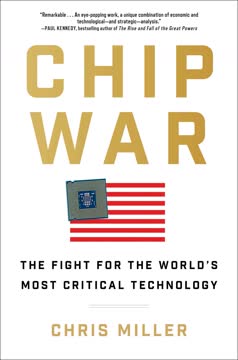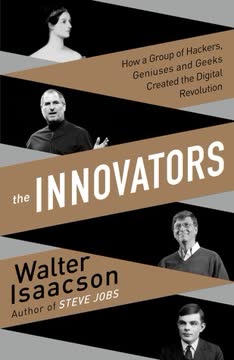Key Takeaways
1. The Digital Revolution: Collaborative Creativity and Distributed Innovation
Innovation requires having at least three things: a great idea, the engineering talent to execute it, and the business savvy (plus deal-making moxie) to turn it into a successful product.
Collaborative creativity drove the digital revolution. The most significant innovations of the digital age sprang from an interplay of creative individuals with teams that knew how to implement their ideas. This collaborative approach was exemplified by institutions like Bell Labs, where diverse talents were brought together in close physical proximity.
Key elements of digital innovation:
- Visionary individuals with breakthrough ideas
- Engineering teams capable of turning concepts into reality
- Business acumen to commercialize and market innovations
- Environments that fostered serendipitous encounters and idea-sharing
- A balance between individual genius and teamwork
The digital age was shaped by the tension between open-source development and proprietary systems, with both models contributing to rapid technological advancement.
2. Ada Lovelace: The Visionary Pioneer of Computer Programming
Ada saw the beauty and significance of an enchanting notion, and she was able to glimpse a future in which machines would become partners of the human imagination, together weaving tapestries as beautiful as those from Jacquard's loom.
Poetical science was Ada Lovelace's unique contribution. As the daughter of Lord Byron, she combined a romantic spirit with a rigorous mathematical education, leading to her groundbreaking work on Charles Babbage's Analytical Engine.
Ada Lovelace's key contributions:
- Wrote the first computer program in history
- Envisioned computers manipulating symbols beyond just numbers
- Conceptualized the potential for computers to create music and art
- Introduced the concept of looping in computer programs
- Speculated on the limits of artificial intelligence (Lady Lovelace's Objection)
Her work laid the foundation for modern computing concepts, demonstrating the potential for machines to augment human creativity and intellect.
3. The Birth of the Computer: From Electromechanical to Electronic
Innovation happens in stages. In the case of the transistor, first there was the invention, led by Shockley, Bardeen, and Brattain. Next came the production, led by engineers such as Teal. Finally, and equally important, there were the entrepreneurs who figured out how to conjure up new markets.
Incremental advances and breakthrough leaps characterized the evolution of computers. The journey from Charles Babbage's Analytical Engine to the first electronic computers involved contributions from numerous inventors and institutions.
Key milestones in computer development:
- ENIAC: First general-purpose electronic computer (1945)
- Manchester Baby: First stored-program computer (1948)
- EDVAC: Introduced the concept of stored programs (1949)
- Whirlwind: First real-time computer with video display (1951)
The transition from electromechanical to electronic computing marked a crucial turning point, enabling faster processing and more complex operations. This shift set the stage for the rapid advancements that would follow in subsequent decades.
4. The Transistor: Revolutionizing Electronics and Enabling Miniaturization
The transistor, as the device was soon named, became to the digital age what the steam engine was to the Industrial Revolution.
Semiconductor physics underpinned the transistor's development. The invention of the transistor at Bell Labs in 1947 by William Shockley, John Bardeen, and Walter Brattain marked a pivotal moment in the history of electronics.
Impact of the transistor:
- Replaced bulky, power-hungry vacuum tubes
- Enabled smaller, more reliable electronic devices
- Paved the way for integrated circuits and microchips
- Sparked the growth of Silicon Valley and the electronics industry
- Led to exponential increases in computing power (Moore's Law)
The transistor's invention exemplified the power of collaborative research and the importance of understanding fundamental physics in driving technological innovation.
5. The Microchip: Integrating Circuits and Powering the Digital Age
The microprocessor spawned hundreds of new companies making hardware and software for personal computers. Intel not only developed the leading-edge chips; it also created the culture that inspired venture-funded startups to transform the economy and uproot the apricot orchards of Santa Clara Valley.
Integrated circuits revolutionized computing. The development of the microchip by Jack Kilby at Texas Instruments and Robert Noyce at Fairchild Semiconductor in the late 1950s laid the groundwork for the modern digital age.
Key aspects of the microchip revolution:
- Miniaturization of electronic components
- Dramatic reduction in cost and power consumption
- Enabled the development of personal computers
- Fueled the growth of the semiconductor industry
- Led to the proliferation of digital devices in everyday life
The microchip's impact extended beyond technology, reshaping industries and economies worldwide, and giving birth to Silicon Valley as the epicenter of technological innovation.
6. The Rise of Video Games: Merging Technology with Entertainment
Innovation is driven by people who have both good theories and the opportunity to be part of a group that can implement them.
Interactive entertainment emerged as a new medium. The development of video games, from early experiments like Spacewar to commercial successes like Pong, demonstrated the potential for computers to provide engaging, interactive experiences.
Milestones in early video game history:
- Spacewar (1962): First widely played computer game
- Magnavox Odyssey (1972): First home video game console
- Pong (1972): First commercially successful arcade game
- Atari 2600 (1977): Popularized cartridge-based home gaming
Video games played a crucial role in making computers more accessible and appealing to the general public, driving advances in graphics, user interfaces, and interactive software design.
7. The Internet: Connecting the World through Decentralized Networks
The Internet was born of an ethos of creative collaboration and distributed decision making, and its founders liked to protect that heritage. It became ingrained in their personalities—and in the DNA of the Internet itself.
Packet-switching technology formed the backbone of the Internet. The development of ARPANET, led by visionaries like J.C.R. Licklider, Bob Taylor, and Vint Cerf, laid the foundation for the global network we know today.
Key concepts in the Internet's development:
- Decentralized, distributed network architecture
- Packet-switching for efficient data transmission
- TCP/IP protocols for network communication
- Collaborative development of standards (RFCs)
- Open architecture promoting innovation and growth
The Internet's design reflected its creators' values of openness, resilience, and distributed control, shaping its future as a platform for global communication and innovation.
8. Personal Computers: Bringing Computing Power to the Masses
Every person who does his thinking with symbolized concepts (whether in the form of the English language, pictographs, formal logic, or mathematics) should be able to benefit significantly.
User-friendly interfaces democratized computing. The development of personal computers, driven by visionaries like Doug Engelbart and Alan Kay, transformed computers from institutional tools to personal devices accessible to everyone.
Milestones in personal computing:
- Engelbart's "Mother of All Demos" (1968): Showcased graphical interfaces, hypertext, and the mouse
- Xerox Alto (1973): First computer with a graphical user interface
- Apple II (1977): One of the first successful mass-market personal computers
- IBM PC (1981): Established the standard for business computing
Personal computers empowered individuals, revolutionized work and communication, and laid the groundwork for the digital society we live in today.
9. The Cultural Convergence: Counterculture Meets Cyberculture
The counterculture's scorn for centralized authority provided the philosophical foundations of the entire personal-computer revolution.
Techno-utopianism emerged from cultural fusion. The convergence of counterculture ideals with technological innovation in the San Francisco Bay Area created a unique environment that shaped the ethos of personal computing and the Internet.
Elements of the cultural convergence:
- Hippie values of personal empowerment and community
- Hacker ethic of open information and hands-on imperatives
- Stewart Brand's Whole Earth Catalog as a bridge between cultures
- LSD and consciousness expansion influencing computer interface design
- Anti-establishment attitudes driving decentralized technologies
This cultural melting pot fostered a vision of technology as a tool for personal liberation and social transformation, influencing the design and purpose of digital technologies for decades to come.
Last updated:
FAQ
What's The Innovators about?
- Focus on Collaboration: The Innovators by Walter Isaacson explores the digital revolution as a collaborative effort, not the work of lone geniuses. It highlights teamwork and shared creativity in technological advancements.
- Historical Context: The book covers key figures from Ada Lovelace to the creators of the Internet, detailing their contributions and the social forces that shaped their innovations.
- Innovative Breakthroughs: Isaacson illustrates pivotal breakthroughs in computing, programming, and the Internet, showing how these developments transformed society.
Why should I read The Innovators?
- Insightful Perspective: The book challenges the myth of the lone inventor, emphasizing collaboration over individualism in the history of technology.
- Engaging Storytelling: Walter Isaacson's narrative style makes complex subjects accessible and interesting, with stories of innovators that are both inspiring and relatable.
- Understanding Modern Technology: By tracing the roots of the digital age, the book helps readers understand the technologies that shape our lives today.
What are the key takeaways of The Innovators?
- Collaboration is Key: Technological advancements are often the result of collaborative efforts rather than individual genius, highlighting the importance of teamwork.
- Interdisciplinary Approach: Combining different fields, such as science and the arts, fosters creativity, as exemplified by innovators like Steve Jobs.
- Historical Lessons: Understanding past collaborations can inspire new approaches to problem-solving in today’s technological landscape.
Who are some key figures discussed in The Innovators?
- Ada Lovelace: Considered the first computer programmer, her work on Babbage's Analytical Engine laid the groundwork for future computing.
- Alan Turing: His concept of the universal machine and code-breaking work during WWII were instrumental in modern computing.
- John von Neumann: His ideas on stored-program computers were crucial for the evolution of computing technology.
How does The Innovators address the role of women in technology?
- Highlighting Contributions: The book emphasizes the significant contributions of women in computing, such as the ENIAC programmers and Grace Hopper.
- Grace Hopper's Influence: Hopper's work in programming languages and compilers exemplifies the vital role women played in shaping the computing landscape.
- Cultural Shifts: Isaacson discusses how societal attitudes toward women in science and technology have evolved over time.
What role did Alan Turing play in the development of computing?
- Concept of the Universal Machine: Turing's theoretical work laid the foundation for modern computing by introducing the idea of a universal machine.
- Turing Test: His proposal of the Turing Test as a measure of machine intelligence remains a significant topic in AI discussions.
- Code-Breaking Contributions: Turing's work at Bletchley Park during WWII was crucial in breaking German codes, impacting the war effort.
How does The Innovators explain the development of the Internet?
- Interconnected Networks: The Internet emerged from military, academic, and corporate efforts, particularly through the ARPANET project.
- Packet Switching Concept: Developed by Paul Baran and Donald Davies, packet switching allowed for efficient data transmission across networks.
- Collaborative Innovation: The development of the Internet was a collaborative effort, with various researchers and engineers contributing to its evolution.
What is the significance of the transistor in The Innovators?
- Foundation of Modern Electronics: The transistor, invented at Bell Labs, replaced vacuum tubes and became the building block of modern electronic devices.
- Enabling the Digital Age: It paved the way for the digital revolution by allowing the creation of integrated circuits.
- Impact on Society: The widespread adoption of transistors transformed industries and everyday life, enabling advancements in communication and information processing.
How does The Innovators address the concept of "open-source"?
- Definition of Open-Source: Open-source refers to software that is available for anyone to use, modify, and distribute, crucial for collaborative projects like Linux.
- Community-Driven Innovation: Open-source projects thrive on community contributions, allowing for rapid innovation and improvement.
- Contrast with Proprietary Software: The book highlights the benefits of open collaboration in fostering creativity and technological advancement.
What is the "Cathedral and the Bazaar" concept mentioned in The Innovators?
- Two Models of Software Development: The "Cathedral" model is a top-down approach, while the "Bazaar" model emphasizes open collaboration.
- Preference for the Bazaar: The Bazaar model often leads to more innovative and robust software solutions, as seen in open-source projects.
- Implications for Innovation: Community involvement in the creative process can lead to better outcomes, highlighting the importance of diverse input.
What are the best quotes from The Innovators and what do they mean?
- “Innovation is not a solo act.”: This quote encapsulates the book's central theme that collaboration is essential for technological advancement.
- “The most imaginative innovators of our time turned disruptive ideas into realities.”: It underscores the role of creativity and imagination in transforming ideas into practical applications.
- “Machines can do whatever we know how to order them to perform.”: This quote from Ada Lovelace emphasizes the limitations of machines in terms of creativity and independent thought.
How does The Innovators illustrate the importance of storytelling in technology?
- Narrative as a Tool: Storytelling is essential for conveying complex technological ideas and making them accessible to a broader audience.
- Humanizing Technology: By sharing personal stories of innovators, the book humanizes technology, allowing readers to connect emotionally with the figures behind the advancements.
- Inspiring Future Generations: The narratives serve to inspire future innovators, showing how passion, creativity, and collaboration can lead to groundbreaking achievements.
Review Summary
The Innovators is praised as an informative and engaging history of the digital revolution, covering key figures and developments from Ada Lovelace to modern tech giants. Readers appreciate Isaacson's focus on collaboration and the intersection of arts and sciences in driving innovation. Some find the technical details challenging, while others enjoy the depth of research and storytelling. The book is seen as important for understanding technological progress, though a few criticize its American-centric perspective and occasional dry sections.
Similar Books










Download PDF
Download EPUB
.epub digital book format is ideal for reading ebooks on phones, tablets, and e-readers.












